
St Joseph's Church, Highgate is a parish of the Catholic Church on Highgate Hill, in the Diocese of Westminster, London. It was founded by the Passionist Congregation in 1858. [1] [2] It is a grade II listed building. [3]

St Joseph's Church, Highgate is a parish of the Catholic Church on Highgate Hill, in the Diocese of Westminster, London. It was founded by the Passionist Congregation in 1858. [1] [2] It is a grade II listed building. [3]
It was in 1858 that St Joseph's was first established by Father Ignatius Spencer, who had converted to the Roman Catholic Church and entered the Passionist Order. He had found the location in Highgate in the Old Black Dog Inn, with a chapel in the ground floor and accommodation for the community on the floor above. The first church was built in 1861/63 by John Bird of Hammersmith but this proved to be too small, and the current church was started in 1888. The new church opened in 1889 by the Bishop of Liverpool, to commemorate the Jubilee of Pope Leo XIII; it was not consecrated until 1932 when the debt had been cleared.
St. Joseph’s Church was designed by the architect Albert Vicars as blend of the Romanesque and Byzantine styles. The green, copper dome is the dominant feature and is a landmark that can be seen from various points across London. The dome is estimated to weigh 2000 tons. St Joseph’s Retreat, the house for the Passionist community, is attached to the east end.
The Stations of the Cross are large painted oblong reliefs by F. Devriendt, installed in 1886.

The high altar has a canopy (or baldachino), made from Sicilian marble. The surrounds and dome of the tabernacle are a copy of the original wooden surrounds from 1861. The mosaic pavement in the sanctuary is made from rock from the bed of the River Severn.
The forward altar of marble and sandstone was erected in 1964 by Gerald Murphy of Burles Newton & Partners. The sanctuary wall paintings are by C. Langlin.
The northeast chapel is dedicated to the Passionist saints and has a painting of the St Paul of the Cross by M.A. Laby.
The Lady chapel is from 1958, the altar is of plain marble with a marble reredos with mosaics showing the Annunciation and Coronation of Mary. The Carrara marble statue of the Virgin (1897) is by Porter of Fulham and is from the earlier chapel. Next to the chapel is a wooden sculpture of St Dominic Barberi by John O’Rourke (1999).
The Sacred Heart chapel is at the southeast.
In St Michael’s Chapel the marble rails and elaborate altar were reputedly exhibited at the Paris Exhibition of 1889. [4] The chapel was erected in memory of Rev. Michael Watts Russell, who died 1875, and there is a marble portrait plaque to him. The reliquary is said to have been designed by Cardinal Wiseman.
The Martyrs Chapel has a marble altar and rails, and an oil painting of the Forty Martyrs of England and Wales.
The segmental, vaulted ceiling was painted by Nathaniel Westlake (1891) and is some of his finest work. There are 250 panels, each segment contains an angel carrying a scroll with a verse from the Te Deum.
The four-manual organ was built by William Hill & Sons in 1898 and installed after the Second World War as a memorial to the local victims of the Second World War.
There are three stained glass clerestory windows on each side wall. Those on the south show the Crucifixion and those on the north the Holy Family. Between the windows are paintings by Westlake depicting the Mysteries of the Rosary.
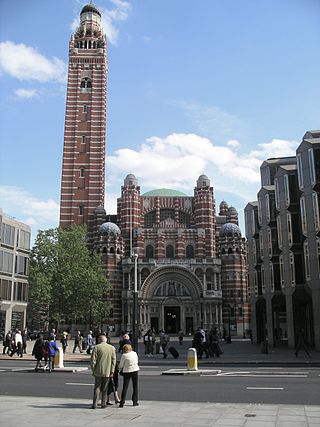
Westminster Cathedral is the mother church of the Catholic Church in England and Wales. It is the largest Catholic church in the UK and the seat of the Archbishop of Westminster.

The Church of the Gesù is the mother church of the Society of Jesus (Jesuits), a Catholic religious order. Officially named Chiesa del Santissimo Nome di Gesù all'Argentina, its facade is "the first truly baroque façade", introducing the baroque style into architecture. The church served as a model for innumerable Jesuit churches all over the world, especially in the Americas. Its paintings in the nave, crossing, and side chapels became models for Jesuit churches throughout Italy and Europe, as well as those of other orders. The Church of the Gesù is located in the Piazza del Gesù in Rome.
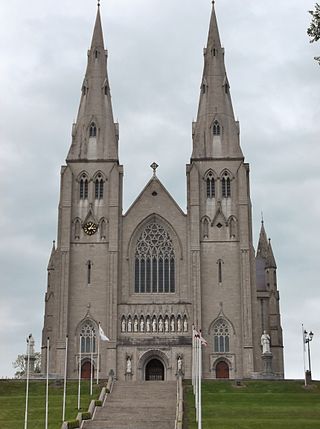
St. Patrick's Cathedral in Armagh, Northern Ireland is the seat of the Catholic Archbishop of Armagh, Primate of All Ireland. It was built in various phases between 1840 and 1904 to serve as the Roman Catholic Cathedral of the Archdiocese of Armagh, the original Medieval Cathedral of St. Patrick having been appropriated by the state church called the Church of Ireland at the time of the Irish Reformation.

Shrine of Our Lady of Guadalupe is a Catholic shrine located in La Crosse, Wisconsin. It is dedicated to the Blessed Virgin Mary under the title of Our Lady of Guadalupe. The 100-acre (0.40 km2) grounds include a visitors' center and outdoor devotional areas such as a rosary walk, Stations of the Cross, and a votive candle chapel. Mass and the sacrament of Penance are celebrated daily by Norbertine canons of St. Michael's Abbey.
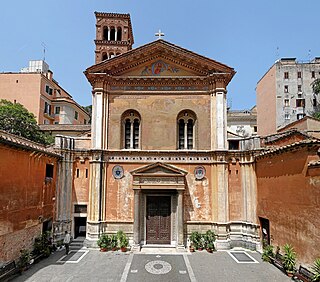
Santa Pudenziana is a church of Rome, a basilica built in the 4th century and dedicated to Saint Pudentiana, sister of Praxedes and daughter of Pudens. It is one of the national churches in Rome, associated with Filipinos.

The Parish Church of St Jude-on-the-Hill, is the parish church of Hampstead Garden Suburb in north London. The suburb was founded in 1907 by Henrietta Barnett to be a model community where all classes of people could live together in attractive surroundings and social harmony.

The Palatine Chapel is the royal chapel of the Norman Palace in Palermo, Sicily. This building is a mixture of Byzantine, Norman and Fatimid architectural styles, showing the tricultural state of Sicily during the 12th century after Roger I and Robert Guiscard conquered the island.

The Minor Basilica of St. Lawrence the Deacon & Martyr is a minor basilica of the Roman Catholic Church in downtown Asheville, North Carolina, United States. The church was designed and built in 1905 by Spanish architect Rafael Guastavino along with his fellow architect R. S. Smith and the Roman Catholic community of Asheville. Pope John Paul II elevated the status of the church to minor basilica in 1993. It is a parish church, located within the Diocese of Charlotte. It is on the National Register of Historic Places and is the only basilica in western North Carolina. Its dome, inspired by the Basilica de los Desamparados of Valencia, has a span of 58 by 82 feet, and is reputed to be the largest, freestanding, elliptical dome in North America. The architectural style is Spanish Renaissance.

St. Adalbert Church is a historic church of the Roman Catholic Archdiocese of Chicago. The church is located on 17th Street between Paulina Street and Ashland Avenue in the Pilsen neighborhood of Chicago, Illinois. St. Adalbert has served generations of Polish immigrants and their American-born children; at its peak, parish membership numbered 4,000 families with more than 2,000 children enrolled in the school. Today, the church is an anchor for the Mexican immigrants that have made the Pilsen area their home.
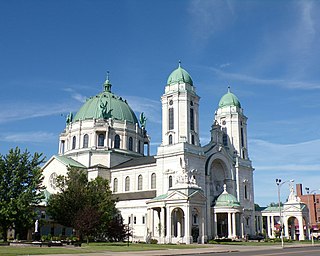
The Our Lady of Victory Basilica is a Catholic parish church and national shrine in Lackawanna, New York. Due to the multiple charities of founder Father Nelson Baker, the shrine is a popular pilgrimage and visitor destination in Lackawanna. It is part of the Diocese of Buffalo.

St Mary Star of the Sea is a Roman Catholic parish church in West Melbourne, Victoria, Australia. The foundation stone of the church was laid in 1882 and the building was completed by 1900. Since 2002, restoration has been ongoing to restore the church to its original state. Built with seating for over 1,200 people, it has been described as the largest parish church in Melbourne, in Victoria, or even in Australia.
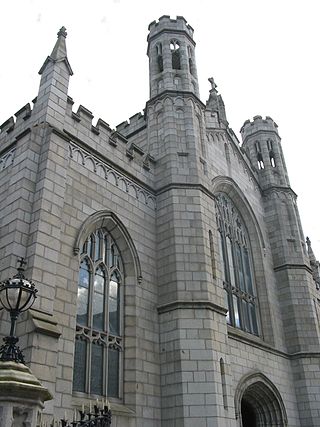
The Cathedral of Saint Patrick and Saint Colman or Newry Cathedral is a Roman Catholic cathedral located in Newry, Northern Ireland. It acts as the seat of the Bishop of Dromore, and the Mother church of the Roman Catholic Diocese of Dromore. Prior to the COVID-19 pandemic, over 200,000 people visited the cathedral each year.

Nathaniel Hubert John WestlakeFSA (1833–1921) was a 19th-century British artist specialising in stained glass.

Saints Peter and Paul Cathedral is a Roman Catholic cathedral located at Fourteenth and Meridian Streets in Indianapolis, Indiana, United States. It is the seat of the Archdiocese of Indianapolis, and of the Archbishop of Indianapolis, most recently Archbishop Charles C. Thompson. Silas Chatard, the first Bishop of Indianapolis, established the cathedral parish in 1892, and named it after Saint Peter and Saint Paul, two apostles of Christ. The cathedral parish became known for its liturgical celebrations and sacred music performances.

The Abbey of Santa Giustina is a 10th-century Benedictine abbey complex located in front of the Prato della Valle in central Padua, region of Veneto, Italy. Adjacent to the former monastery is the basilica church of Santa Giustina, initially built in the 6th century, but whose present form derives from a 17th-century reconstruction.
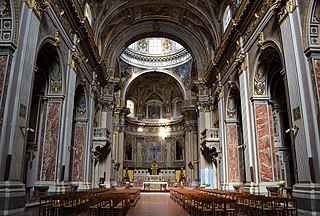
Santi Apostoli is a Baroque-style church in Naples, Italy.
The Pippet Family are a family of designers and artists based in Warwickshire and Birmingham, who specialised in Catholic decorative schemes for churches, ecclesiastical metalwork and stained glass windows as well as some textile items. They were part of the British Gothic Revival, notably working for John Hardman & Co in the style of Pugin.

Église Saint-Joseph-des-Carmes (Saint-Joseph-des-Carmes) is a Roman Catholic church located at 70 rue de Vaugirard in the 6th arrondissement of Paris. It was originally built as the chapel of a convent of the mendicant order of Shoeless Carmelites. It is now the church of the Catholic Institute of Paris, a university-level seminary for training priests, and is also a parish church for the neighbourhood. It is dedicated to Saint Joseph, husband of the Virgin Mary. Built between 1613 and 1620, it combines elements of Classical architecture on the exterior with a remarkable display of Baroque architecture and art in the interior. The chapel is open to the public at limited hours.
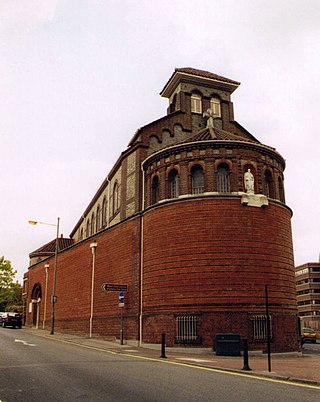
St Joseph's Church is a Roman Catholic Parish church in Aldershot, Hampshire. Built in 1913, it is situated at the top of a ridge on Queens Road, overlooking the town centre, between the Municipal Gardens and Princes Hall. It is a Grade II listed building. Sir Nikolaus Pevsner described it as 'One of the most impressive churches of its date, brilliantly planned on a triangular site.'

San Vitale is a Baroque style, Roman Catholic church located in central Parma, region of Emilia Romagna, Italy.